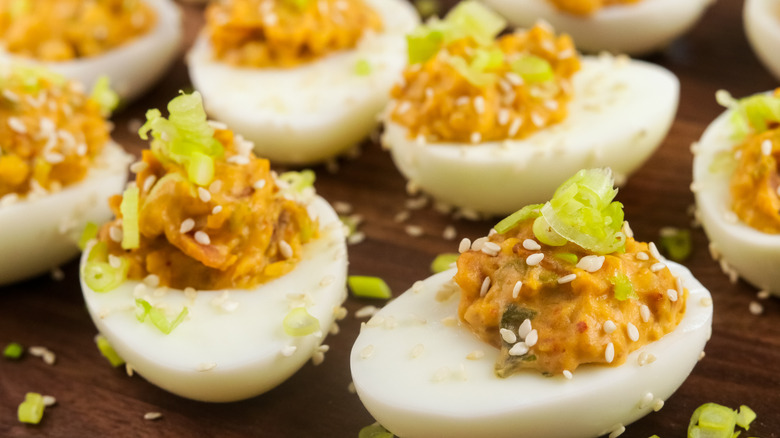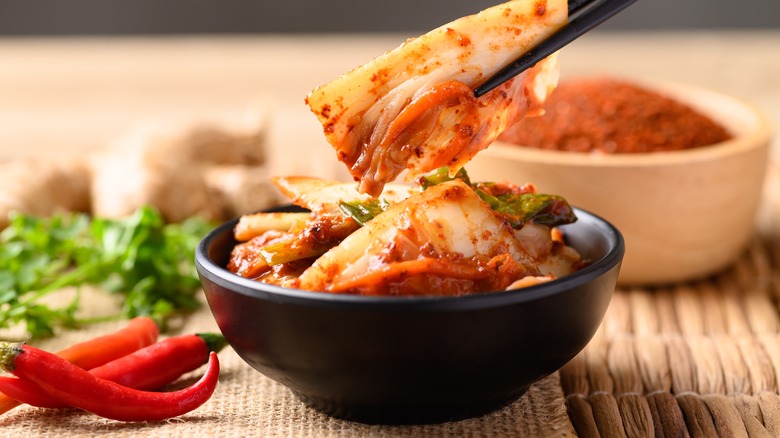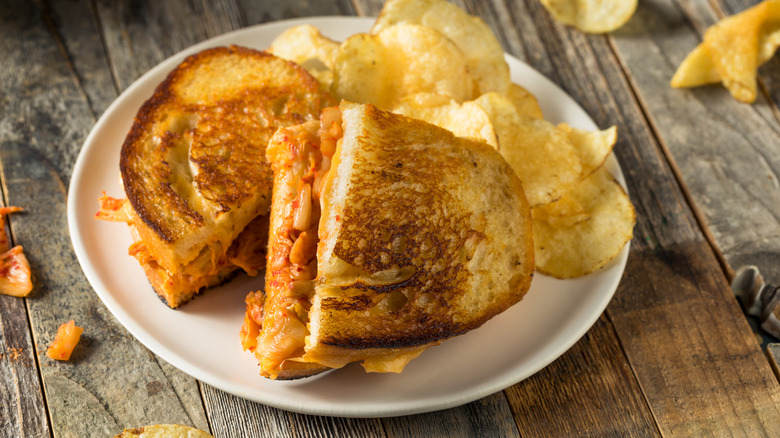Top Your Deviled Eggs With Kimchi For A Huge Flavor Punch
As far as appetizers go, it doesn't get more classic than the deviled egg. It's both dainty and humble, making it suitable for all sorts of celebrations — from picnics and backyard barbecues to Bar Mitzvahs and weddings. But the idea of the deviled egg is nothing new; the combination of pungent sauce and hard-boiled eggs dates all the way back to ancient Rome. However, the "deviled" moniker is a relatively new contribution to the culinary lexicon, originating in Great Britain during the late 18th century and referencing any sort of food that's been boldly seasoned or spiced. It was only in the mid-20th century that mayonnaise was added to the mix, creating the deviled egg most people are familiar with today. However, the Korean fermented cabbage provides a satisfying counterbalance to the typically decadent combination of yolk and mayonnaise, and it is a must-try for all deviled egg lovers.
And as food trends twist and change, the deviled egg continues to evolve with them. Now you can find recipes for deviled eggs that are deep fried, smoked, mixed with bleu cheese, stuffed with avocado, or even dotted with caviar. These variations all have their merits, but for a devil-egg that's all things spicy, tangy, rich, and tart, you have got to incorporate a kimchi topping.
Why kimchi and deviled eggs are a natural match
The basic deviled egg is simple to put together: Hard-boil your eggs, peel, slice lengthwise, remove the yolks, mix them with mayonnaise and seasonings, and then pipe back into the egg white for a pretty presentation. Adding kimchi and a few other Korean ingredients preserves the elegance of the deviled egg while giving it a more exciting and sophisticated flavor. Kimchi is a type of spicy fermented vegetable with ancient roots that is typically made with either cabbage, radish, or cucumber. It's basically a chile-rubbed pickle that's all things sour, hot, and delightfully funky, which is why it's such an appropriate foil to the creamy richness of egg yolk.
Incorporating the flavor and texture of kimchi into your deviled egg doesn't require too much technique. You can buy a jar of kimchi (it's typically sold in the refrigerated section near the pickles), dice some up, and fold it into your egg yolk mixture. Layering a few slivers atop your finished deviled eggs is another option if you want more of a crunch. But if you're looking to take the flavor of your deviled eggs up another notch, mix in a squirt of gochujang, a spicy fermented Korean chile paste, into your egg yolks. This will amplify the heat level, while also adding a pleasant tingle to every bite.
Other ways to incorporate kimchi into your cooking
Kimchi can help bring harmony to any number of dishes. Its taste characteristics — spicy, acidic, tangy — serve as a nice counterpoint to foods that are rich or starchy. One of the most common applications is to mix diced kimchi with leftover grains for tasty fried rice. It's also an excellent topping for a hamburger or chicken sandwich, taking the place of the more traditional combination of ketchup, onion, and pickle. As chefs and home cooks are experimenting with even more fusion cuisine, kimchi is starting to appear in or alongside many classic American comfort foods. Macaroni and cheese, French fries, grilled cheese, hot dogs, and even pizza all stand to benefit from the pungent addition of kimchi.
However, where the ingredient really shines is in soups and stews. A whole book could be written on the subject, but any sort of tomato or dashi-based broth can benefit from some sautéed kimchi at the bottom of the pot. You can even eat kimchi for breakfast. Fold some into your omelet or scrambled eggs for an innovative morning meal. Although all delicious, these eggy combinations won't match the look and flare of kimchi-deviled eggs.


